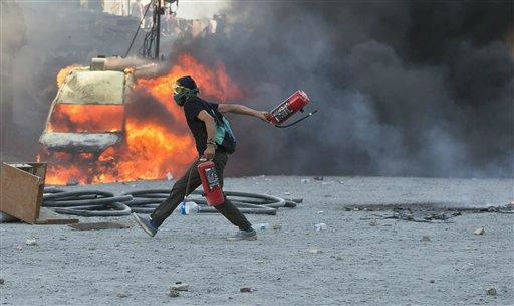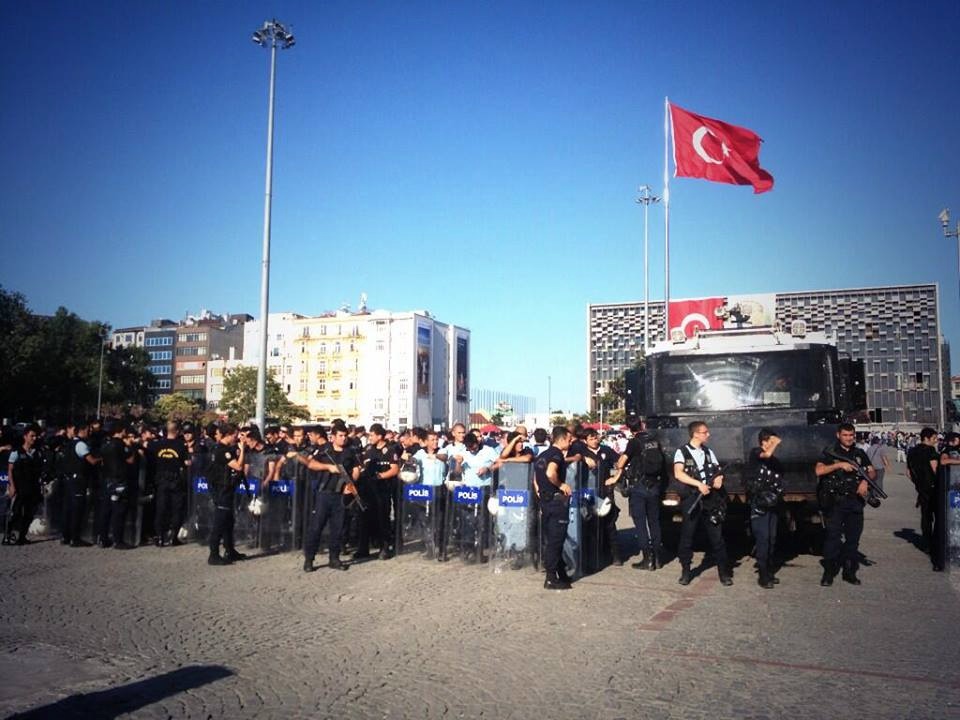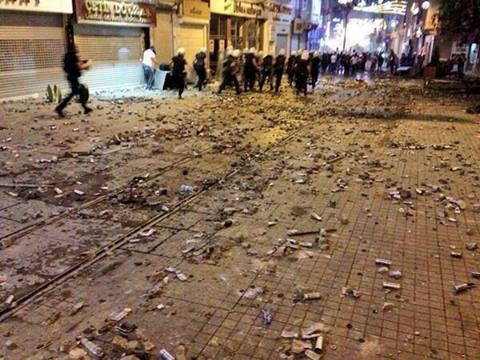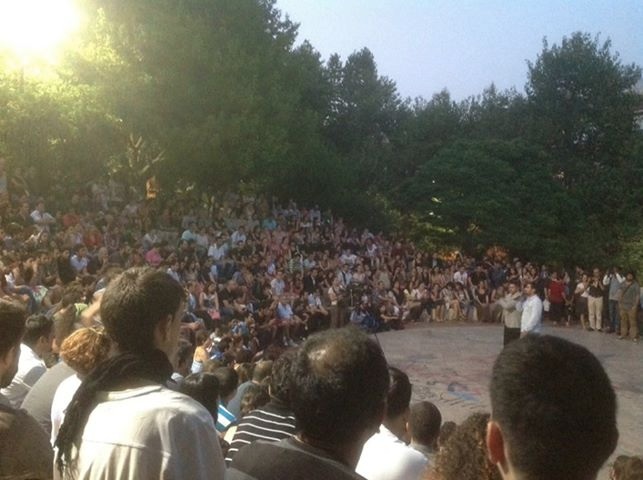As I started writing from Tarlabasi, Istanbul, the police were fortifying Taksim Square to prevent peaceful protesters from entering. They were there to protest the release of the policeman who murdered one of our comrades in Ankara, Ethem Sarisuluk. He was shot in the head, and a video has been released clearly revealing the murder. Despite abundant evidence and witnesses to the contrary, courts released him on the basis of “self-defense” and will continue his trial without detention. With this decision, the partiality of the legal system in favor of the brutal police forces became obvious once again.
Many things can be said – and have already been said – about the protests that began on May 28th at Gezi Park. I will be brief about its overall development, and will instead simply recount some of my personal experiences during the most ferocious police attacks.
First things first. Gezi Park is the last green space at the center of Istanbul, Taksim, which has gradually diminished over the years by being sold off to big hotels and corporations. After the demolition of the Ottoman Barack in 1940, Gezi Park was built to cover all of the area from Taksim to Inonu Stadium. Now there are hotels like the Hilton on those locations. The initial protests began with a few activists occupying the last remainders of this park in order to stop the demolition of the trees, which the municipality planned to replace with a shopping mall in the shape of the old Ottoman Barack. Police forcefully attacked these peaceful protesters, and the more the state tried to crush this initially small resistance, the bigger it grew. This led to the huge clashes with the police on May 31st and finally the total occupation of the park and Taksim Square on June 1st. From that day to the 11th, Taksim fully lived the motto a protester inscribed on a banner: “No Police, No Problem.”
Of course, there were some problems, which emerged from an unprecedented gathering of hundreds of thousands experiencing the kind of empowerment that that had been forbidden to them for most of their lives. However, it wasn’t at all like the times when police were present. In fact, the problems arising were mostly due to the imminent danger of police attacks and the atmosphere of terror emerging from that.
I neither aim to tell you about the 10 glorious days that many named “The Taksim Commune,” nor the dynamics behind the uprisings. But I do want to describe the instances where I directly witnessed the brutality of the Turkish police between June 11th to 16th – though I am among the lucky ones who haven’t experienced or witnessed the worst cases. I am not among the four who lost their lives. I am in fact lucky enough not even to witness those murders, because police detained even the witnesses of Ethem’s murder and attorneys are charging them with attempted murder of the killer police. Neither am I among the 11 who lost their eyes due to the gas canisters, nor 59 whose injuries are still life-threatening. Not even among the 7,959 whose injuries have been documented as of June 24th. I am among the lucky ones. But even as the lucky ones, even we were exposed to extreme violence by the police in the last weeks and our movement is going through severe police state repression.
I spent my last two days in the Istanbul attorney generalship and human rights foundation to officially complain about the Turkish police and government about the harms they have caused me personally. Will it make any difference? I don’t think so, but I wanted to give ammunition to lawyer comrades who are fighting a legal war. Anyway, these two days made me think that despite the relative insignificance of what I saw and experienced, it would be worthwhile to put it in writing.
On the June 11th, the atmosphere were very tense at Gezi Park. In the morning, police attacked and invaded Taksim Square with its TOMAs, giant vehicles spraying chemical water that burns. Governor Mutlu announced that their only aim was to reset the symbolic order at Taksim Square by removing the banners on the Monument of Republic and Ataturk Cultural Center. He said they would by no means attack at Gezi Park. Then around 8pm, just before dark, gas canisters started to rain into the park. The bitter joke among the protesters: the governor’s words always shows us the truth, but only in reverse! People started to run in opposite directions, trying to escape from the effects of the gas. But gas disperses very quickly and even in areas that it is not visible, it is effective. Some of us were prepared and immediately wore our goggles, gas masks, and helmets. Those with experience at the barricades immediately formed groups to extinguish the canisters in big bottles of water. It is an ingenious method but still quite hard to exercise. When a canister is launched, watchers with gloves run towards it, sometimes while it is still spinning on the floor. They capture them, put them in large water bottles, and cover them. Unless it is covered, gas does not extinguish in water immediately. It has to be suffocated as well. Thanks to these efforts, the effects of the gas diminished in the park, but were not completely effaced. We all got severely affected by the gas, and the canisters themselves, which are deliberately used by police to hit people. This lasted all night. There were clashes on all three sides of the park, leaving only the Sisli side open. Injured people constantly flowed into the three medical locations. I was close to the one on the east side. We formed human chains to keep the paths to the medical tents open and help carry the injured. Despite ongoing attacks to the park, it was full of people refusing to vacate it. There were some actively clashing with the police, and some doing it passively by enduring the conditions at the park and providing support, medical and otherwise. I can’t forget one guy who was exposed to too much gas and was in shock. Apparently someone gave him a gas mask afterwards, and he stuck to it even where there was no gas. Everyone told him he could let go, but he wouldn’t; he kept breathing irregularly through the mask, holding it with one hand. When he let go, his face showed the hell he had left.
It was a surprise that police didn’t invade the park that night. Prime Minister Erdogan and Governor Mutlu started to play a different game the following day. Trying to improve their image, especially in the international media – most of the national media belongs to those who are economically and politically close to them or under severe pressure by the government – they staged laughable negotiations with our supposed representatives. On June 12th, Erdogan met with a group of his own selection and presented it as negotiations with us. After this grotesque lie was exposed, he was forced to accept five of our representatives from Taksim Solidarity. But rather than listen to them, he scolded the delegates. In response Solidarity declared that it resolved to continue the occupation. In the meantime, Erdogan gave two deadlines to vacate the park, which resulted in even a greater crowd. Especially on the 14th, Friday, the “Mothers Are Here” event changed the atmosphere, diminishing the expectations of a police attack.
However, on Saturday, June 15th, when the park was crowded by people simply touring the spectacle – mostly children, women, and the elderly – police attacked abruptly. I was passing through the square with two friends carrying zines called Gezi Postasi when police made a feeble warning that could only be heard from the square side of the park. The “warning” was scary but we thought the park was too crowded for them to attack at that moment. We were rather excited to distribute our freshly printed zines, hoping that it would supply new perspectives to the seven forums being held in different parts of the park. Intellectuals’ delusion! Within minutes gas canisters and sound bombs started to explode, and this time riot gear police moved into the park. We were used to the gas and sound bombs, but riot police marching and beating people created a burst of panic. I was in the group who were escaping towards Sisli, Harbiye. Many thousands were flowing up the Cumhuriyet Boulevard. However, riot gear police and their TOMAs were approaching faster than the group could move, squeezing the crowd tighter and tighter. They were attacking not to disperse but definitely to hurt and punish, which is a very common police practice in Turkey. While the TOMAs sprayed chemical water just behind us, and riot gear police were striking with their truncheons next to it, they also sent gas bombs ahead of us. Anyone trying to escape from the police ran straight into the gas. The gas trail lasted approximately for a kilometer. At one point I wasn’t able to breathe and was about to collapse. My friend held and dragged me. When we reached the Metro station at Osmanbey, we made a huge mistake by thinking that we could take the metro and get the hell out of there. As we started to enter, we encountered people escaping from gas thrown into the metro station. We found ourselves in the stampede back again, and finally found a back street. When finally I reached home, I posted this message:
There were several children in the park when they started this brutality. It is horrible to fall into the gas even with gas masks. Mine didn’t help where gas was dense. I cannot imagine the harm this caused to unprepared people and children. As an adult person wearing a mask, I wasn’t able to breathe, and thought I was going to faint and die. Police did not just attack to disperse us. They attacked to torture and punish us. The panic and pain when police were coming behind us and sending gas bombs ahead of us were indescribable. Their attack is still continuing. I was shocked and am still afraid, but I know that if we stop claiming our rights now they will steal even more of them.
After Sisli, police attacked every other side of Gezi Park and managed to take its control. In the meantime, thousands gathered in different parts of the city but police blocked their way and started to attack even small groups. I went back to Taksim the morning of June 16th. Every single road to the Square and Istiklal street were blocked. Police were operating as an organized crime gang on the back streets of Taksim. They were cursing and beating whoever they could get their hands on. They were confiscating the gas masks, helmets, and goggles they found in people’s bags, and holding them as equipments of crime. Even attorneys backed police in this practice and charged the possession of this purely defensive equipment as tools of crime. The whole day passed by as we tried to gather in different locations to march towards Taksim Square. However, police attacks were ferocious and our resistance could only slow it down. Meanwhile Prime Minister Erdogan held a meeting elsewhere in the city. He bragged as if his supporters were larger than the dispersed groups clashing with the police. Again Erdogan’s police created the stage for his lies to appear as truth, by forcefully intervening in the reality.
After the invasion of Taksim Square and Gezi Park, people dispersed and occupied the parks in their neighborhoods. Currently there are more than 40 forums being held in different parks in Istanbul, and countless more all over the country. In these forums people are trying to find alternative ways to resist the allied oppression of capital and the state, and to create their own forms of self-governing. The forums, which converge every Saturday evening, are trying to take the square and Gezi Park back. The last two Saturdays, the police repeated their fascistic attacks, and do not seem to be changing their attitude for the upcoming ones. The state has begun a witch hunt, raiding people’s homes and arresting hundreds. Is this ultimately the victory of the police state in Turkey? Or will its loss of legitimacy eventually lead to its downfall? We are still struggling for the latter.
 Viewpoint Magazine
Viewpoint Magazine


